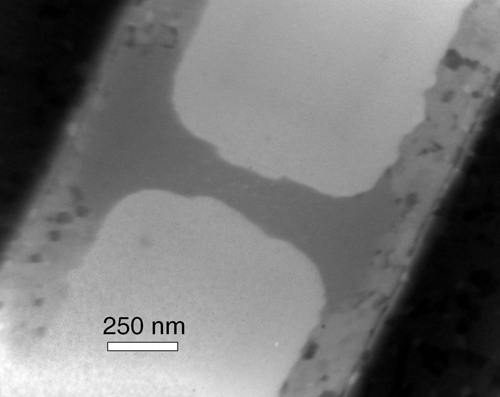Successor to flash memory lasts much longer
We all use flash memories. They’re in our mobile phones, as SD cards in our cameras or in our USB sticks. But this permanent memory has several disadvantages. Research by Jasper Oosthoek has shown that the hardier phase-change memory, as it is known, is a much better alternative. Oosthoek will be awarded a PhD by the University of Groningen on 11 April.
Oosthoek conducted his research into the structure of phase-change memory cells in association with NXP (formerly Philips Semiconductors).
Phase-change memory
Phase-change memory is used in rewritable CDs and DVDs. The material used to build the memory cells is heated with a laser. It only needs heating slightly to crystallize and form an organized structure; more heat will cause it to melt, creating a disorganized, amorphous structure. ‘Each phase has a different electrical conductivity, which enables you to make a switchable memory cell’, explains Oosthoek. The material he is researching does not switch with laser light, but with an electrical pulse. ‘Apart from this, it’s much the same. The pulse heats the material. If it is heated to 500 degrees Celsius and then cooled, it will produce a well-organized structure. If heated to 800 degrees and cooled quickly, it produces an amorphous structure.’
NXP had produced a series of memory cells and wanted to know exactly what happened to the material during the switch at various temperatures. The company applied to the Zernike Institute for Advanced Materials of the University of Groningen for help. Powerful electron microscopes enable analysts to study the structure of the material in minute detail. ‘But you can’t just pop these memory cells into an electron microscope’, says Oosthoek. For a clear image, the memory cell cannot be thicker than 200 nanometres (a nanometre is a millionth of a millimetre), and memory chips are much thicker than that. ‘So you have to remove a lot of material first, which makes the cell very delicate.’
Tilted H
These cells resemble a tilted H (see photo below), with a thin connecting piece joining two thicker pieces. The thin connector determines the electrical resistance of the memory cell. Oosthoek managed to produce clear images of the memory cells, which had been switched to crystalline or amorphous states beforehand. ‘We noticed that the thin connecting piece was not uniformly amorphous and concluded that the heat must travel through the connector along with the electrons, causing it to heat unevenly.’
Oosthoek also discovered that frequent switching can cause material to leak out of the thin connecting piece. ‘In both cases, this is a good reason to reconsider the shape and material used for the memory cells. There is certainly room for improvement.’
Good power handling capacity
Oosthoek ascertained that the phase-change memory cells had good power handling capacity. ‘Flash memory can switch around ten thousand times before there’s a chance that it will stop working. Phase-change memory appears to last about ten to a hundred times longer.’
Tests at Samsung show that phase-change memory is faster than flash. But Oosthoek knows that much more is being invested in research into flash memory than into phase-change. Companies like Samsung and Nokia initially became interested in phase-change memory amid concerns that flash memory could not be made any smaller. ‘This was a realistic fear seven years ago, when this project started. But nowadays we know that there is still plenty of leverage in flash memory’, continues Oosthoek.
Having said this, phase-change memory is still faster and potentially more stable than flash. A lot of development work is needed to optimize these memory cells. Oosthoek thinks that phase-change memory stands a good chance of ousting flash. ‘Particularly in a niche market like space travel. Flash memory is extremely sensitive to radiation, while phase-change material can cope with it very effectively.’
Curriculum Vitae
Jasper Oosthoek will be awarded a PhD for a thesis entitled ‘Structural and electrical characterization of phase-change memory line cells’. The research was carried out in the Nano-structured Materials and Interfaces Department of the Zernike Institute for Advanced Materials. Prof. Bart Kooi headed the research, which was funded by the Materials Innovation Institute (M2i) and NXP.

| Last modified: | 14 September 2021 1.39 p.m. |
More news
-
19 April 2024
New thesis prize for master's students of Economics and Business
How can we encourage economics and business students to deal with important societal challenges in their master's thesis? The 14 Dutch faculties of economics and business, united in the Council of Deans in Economics and Business (DEB), have set up...
-
18 April 2024
Ward Romeijnders appointed as Professor of Optimization under Uncertainty
The Faculty of Economics and Business is pleased to announce that Ward Romeijnders has been appointed as Professor of Optimization under Uncertainty. The chair is situated within the Department of Operations.
-
18 April 2024
PET-scan expert Jan Pruim benoemd tot Officier in Orde van Oranje Nassau
Hoogleraar medische beeldvorming Jan Pruim is bij zijn afscheid van het UMCG benoemd tot Officier in de Orde van Oranje Nassau. De koninklijke versierselen werden hem op woensdag 17 april uitgereikt door burgemeester Koen Schuiling van de gemeente...
